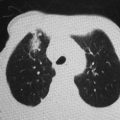, Ahmad Ameri1 and Mona Malekzadeh2
(1)
Department of Clinical Oncology, Imam Hossein Educational Hospital, Shahid Beheshti University of Medical Sciences (SBMU), Shahid Madani Street, Tehran, Iran
(2)
Department of Radiotherapy and Oncology, Shohadaye Tajrish Educational Hospital Shahid Beheshti University of Medical Sciences (SBMU), Tehran, Iran
Acute gastrointestinal complications occur in 80% of patients in pelvic radiation therapy [1]. The small intestine appears to be more sensitive to radiation than the colon and rectum [2] and is also more frequently exposed incidentally to radiation during treatment of adjacent organs because of its situation within the peritoneal cavity.
Different intestinal side effects were reported in the Postoperative Radiation Therapy in Endometrial Cancer (PORTEC-2) Trial, which found that among 214 women with endometrial cancer treated with external beam radiation therapy after total abdominal hysterectomy and oophorectomy, the rates of diarrhea, fecal leakage, rectal blood loss, and bloating were all increased from the baseline at a rate of 22%, 5.3%, 1.8%, and 0.7% at 1–4 weeks after the end of treatment, respectively [3].
In a study of 107 patients with gynecologic, urologic, or gastrointestinal cancer within the pelvis that underwent radiation therapy, acute gastrointestinal toxicities were assessed during the treatment. It was found that 94% of patients developed altered bowel habits, 80% loose stool, 74% frequency, 65% difficult gas, 60% pain, more than 48% distress, 44% tenesmus, more than 40% restrictions in daily activity, 39% urgency, 37% fecal incontinence, and 40% required antidiarrheal medication [4].
15.1 Mechanism
The intestinal epithelium is a single layer of columnar cells containing crypt-villous units. Villous protrusions increase the absorptive surface of the small intestine. Undifferentiated rapidly proliferating stem cells are in crypts that are dividing and converted to other differentiated cells including enterocytes that migrate to the villous epithelium. The crypt-villous units are substantially degenerated in organization after radiation injury.
Radiation initially induces mitotic arrest in stem cells. Cryptal surface cell layers become swollen with nuclear shrinkage and degenerative cytoplasmic changes and necrosis occur. Villi become shortened with a decrease in enterocyte cell number and microvilli length and number, leading to absorptive capacity reduction. Acute inflammatory reaction, leukocyte migration (mostly polymorphonuclear leukocytes and eosinophils), increased microvascular permeability, hyperemia, and edema all occur causing tissue damage and mucosal breakdown, and, ultimately, ulceration will develop [2]. Small bowel bacterial overgrowth also may occur during pelvic radiation therapy in some patients and is likely related to gastrointestinal symptoms [5].
Damaged epithelium results in impaired absorption of bile salts, fats, carbohydrates, proteins, and vitamin B12 during radiation therapy [6].
The small bowel motility pattern also changes during radiation therapy. The exact mechanism of this change remains unclear. Some proposed mechanisms are related to alteration in neurotransmitters release, activity and sensitivity, mucosal injury, and change in water and electrolyte absorption or alterations in the function of the smooth muscle cells [7, 8].
15.2 Timing
Symptoms such as cramping and diarrhea usually develop about 1–2 weeks after the start of radiation therapy (5–12 Gy in fractionated radiation therapy) [9, 10], and its peak is reached by the fourth to fifth week [10]. Symptoms gradually decrease in severity within 2–6 weeks after treatment [11, 12], but it could last longer [13].
15.3 Risk Factors
Radiation dose and the volume of small bowel exposed to radiation correlate with incidence and severity of acute enteritis [14, 15]. Small bowel loops are freely moving within the peritoneal cavity, and defining exact dose-volume parameters that are consistent during the entire course of radiation therapy is not possible. Kavanagh et al. found that severe acute small bowel toxicity could be prevented if the volume of small bowel receiving radiation doses more than 15 Gy is kept under 120 mL (D15 < 120 mL) when bowel loops are contoured as normal tissue volume; however, if the entire peritoneal cavity is considered as small bowel volume, the volume receiving more than 45 Gy should be kept under 195 mL (D45 < 195 mL) [9].
Chemotherapy concomitant with radiation therapy increases the risk of all grades of acute enteritis, especially higher grades [16–18]. A systematic review of acute and late toxicity of concomitant chemoradiation for cervical cancer has reported a twofold increase in acute grade 3 and 4 gastrointestinal toxicities in patients treated with chemoradiation therapy rather than radiation alone [18].
Inflammatory bowel disease (IBD) is a known risk factor for small bowel radiation-induced toxicity, though very scant data are available. Irradiation can exacerbate IBD symptoms; IBD also increases the acute and late side effects of radiation therapy significantly. Acute gastrointestinal toxicity that results in radiation cessation was more than 20% in a retrospective study of 28 patients with IBD that underwent external beam abdominal or pelvic irradiation, and there was no difference in acute toxicities between patients with Crohn’s disease and ulcerative colitis. It is recommended that radiation should be used with caution in these patients [19]. If the radiation therapy is mandatory, efforts should be made to spare the normal gastrointestinal tissue. Selecting appropriate patient position, computed tomography (CT) simulator with contrast agent, and using more conformal treatment techniques are effective to determine gastrointestinal tract irradiated volume and doses.
Previous abdominal surgery is related to risk of acute enteritis due to a larger volume and fixed loop of small bowel within the radiation field [20, 21]. Type of surgery may be important in this view. In a retrospective study of 120 patients with rectal cancer that received chemoradiation, severe radiation-induced diarrhea was more common in patients with sphincter-preserving procedures versus abdominoperineal resection [22].
Low body mass index [14] and female gender [22] have been reported to be associated with radiation-induced enteritis.
Diabetes, hypertension, age, field design, and number (two-, three-, or four-field technique) have not been reported to significantly increase acute toxicity of pelvic radiation [11].
15.4 Symptoms and Diagnosis
Acute injury to small bowel manifests mainly with diarrhea with or without abdominal cramping during or shortly after radiation therapy. The diarrhea secondary to acute radiation enteritis may be associated with decreased absorption of bile salts, vitamin B12, lactose, fat, and more rapid small intestinal transit [13]. Nausea and vomiting, bloating, and loss of appetite may occur [10, 13]. Weight loss can be a secondary finding. Rarely, obstructive symptoms or bowel perforation due to profound acute enteritis may occur and require surgical intervention, especially in patients with underlying inflammatory disease [23].
15.5 Scoring
Radiation Therapy Oncology Group (RTOG) and European Organization for Research and Treatment of Cancer (EORTC) have classified all symptoms related to lower gastrointestinal and pelvic tissue in the single scoring category (Table 15.1) [24].
Table 15.1
RTOG/EORTC lower gastrointestinal toxicity
Definition | |
|---|---|
Grade 1 | Increased frequency or change in quality of bowel habits not requiring medication/rectal discomfort not requiring analgesics |
Grade 2 | Diarrhea requiring parasympatheticolytic drugs (e.g., Lomotil)/mucous discharge not necessitating sanitary pads/rectal or abdominal pain requiring analgesics |
Grade 3 | Diarrhea requiring parenteral support/severe mucous or bloody discharge necessitating sanitary pads/abdominal distention (flat plate radiograph demonstrates distended bowel loops) |
Grade 4 | Acute or subacute obstruction, fistula, or perforation; GI bleeding requiring transfusion; abdominal pain or tenesmus requiring tube decompression or bowel diversion |
Diarrhea is the main symptom of radiation-induced enteritis, and Table 15.2 shows the Common Terminology Criteria for Adverse Events (CTCAE) v4, which classifies diarrhea into five grades [25].
Table 15.2
CTCAE v4, diarrhea scoring
Definition | |
|---|---|
Grade 1 | <4 stools per day over baseline; mild increase in ostomy output compared to baseline |
Grade 2 | Four to six stools per day over baseline; moderate increase in ostomy output compared to baseline |
Grade 3 | ≥7 stools per day over baseline; incontinence; hospitalization indicated; severe increase in ostomy output compared to baseline; limiting self-care ADL (activities of daily living) |
Grade 4 | Life-threatening consequences; urgent intervention indicated |
Grade 5 | Death |
15.6 Prevention
Frequently, different volumes of small bowel have to be included in irradiation portals when abdominal or pelvic tumors are treated with radiation therapy. It should be attempted to reduce the bowel volume in radiation portals or at least exclude from high-dose exposure by various techniques such as patient positioning, use of a belly board, treatment with a full bladder, or using multiple-field techniques [26–28].
Prone positioning on belly-board devices is an appropriate way to spare the small bowel in both 3D-CRT (conformal radiation therapy) and IMRT (intensity modulated radiotherapy) treatment plans [29, 30], although it may increase large bowel volume in the treatment field when the limited arc technique is used [29].
With the introduction of new techniques for radiation delivery like IMRT, small bowel volume with high radiation doses and resultant radiation toxicity have decreased [31–34].
A number of surgical techniques have been applied for bowel exclusion from the radiation field in patients with postoperative pelvic radiation therapy that have used prosthetic materials (e.g., absorbable mesh or saline-filled tissue expanders) or omentum [35–37]. These interventions are not routinely used in many centers [10].
European Society for Medical Oncology (ESMO) clinical practice guideline recommends using systemic sulfasalazine at a dose of 500 mg administered orally twice a day to prevent radiation-induced enteropathy in patients receiving radiation therapy to the pelvis.
There are many preventive options that have been discussed in the literature but cannot be recommended due to insufficient evidence [38–46].
Elemental nutritional formulas, low-lactose, low-fat, and low-fiber diets, and probiotic preparations currently cannot be considered in clinical practice as prophylactic interventions until better determination of their safety and efficacy is made [42].
Amifostine [39] and vitamin E [40] before radiation therapy as well as angiotensin I-converting enzyme inhibitors (ACEi) and 3-hydroxy-methylglutaryl coenzyme A reductase inhibitors (statins) [41] during radiation therapy appear to provide protection against lower gastrointestinal toxicity. These primary promising results need to be established in future studies.
Glutamine is a major source of energy for intestinal epithelial cells and is necessary for cellular proliferation, mucosal cell integrity, and immunological protection of the small bowel [46, 47]. A protective effect of oral glutamine on the small bowel mucosa has been suggested in several studies with contradictory results [43–46]. There is insufficient data to draw a definitive conclusion.
Different cytokines and peptides have been evaluated for protecting the gastrointestinal tract from radiation side effects. The protection effects of insulin-like growth factor-I (IGF-I) on small intestinal mucosal radiation damage have been proposed in animal studies that need further evaluation [48–51]. Several other agents including immunomodulators (e.g., orazipone, interleukin-11) [37, 52], trophic agents like glucagon-like peptide-2 and its dipeptidyl peptidase-4 (DPP-IV) resistant analog teduglutide [53], and other growth factors [54, 55] are proposed to modulate small intestine injury.
A circadian diurnal variation in the number of apoptotic cells in the intestinal crypt has been shown in animal studies to affect radiation-induced enteritis frequency [56, 57]. In a randomized study of 229 patients with cervical carcinoma that were treated with radiation therapy in the morning (8:00–10:00 AM) or evening (6:00–8:00 PM), the overall incidence and severity of diarrhea in patients increased with the morning treatment as compared with the evening [38]. Currently there is no recommendation for this observation in clinical practice.
15.7 Management
The key point in the approach to patients with radiation-induced diarrhea is determining the severity of diarrhea and patient’s general condition. Mild to moderate diarrhea without any other significant symptoms and signs can be treated in the outpatient setting with dietary modification, antidiarrheals, and antispasmodics (see below). All of these patients should be examined every 24 h [58].
Stay updated, free articles. Join our Telegram channel

Full access? Get Clinical Tree






